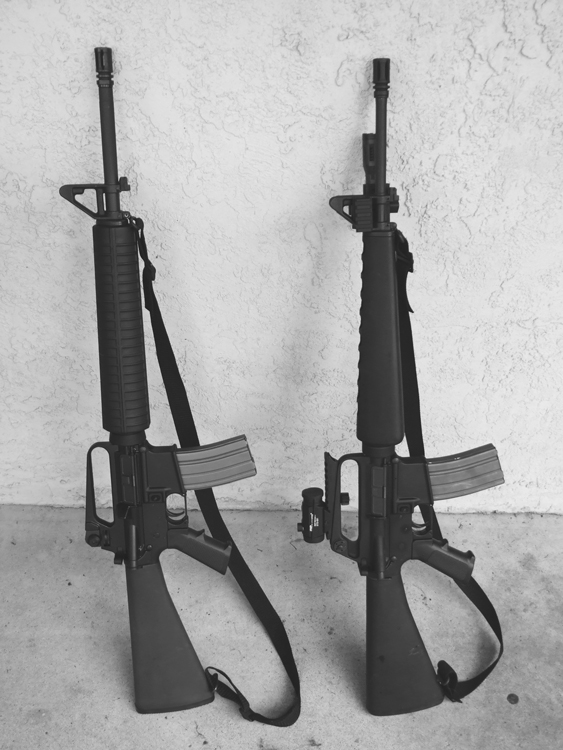At GunDigest, we independently review products. However, we may earn a commission when you purchase through links on our site. Learn More
Survival Guns: Advantages of the 20-Inch AR-15

Full-length 20-inch ARs with the original pencil-thin barrel profile are rather hard to find these days, but it's my top choice among survival guns.
Among my primary survival guns is the C15A1 produced by Century International Arms. Using an original surplus M16A1 upper receiver—forward assist, no case deflector, birdcage-enclosed flash suppressor, original triangular handguards, and fool-proof sights, Century added a new 20-inch, 1:9 barrel, a new forged lower receiver, and topped it off with an original, shorter, exactly-right-the-first-time A1 buttstock.
I’m here to tell you, this is the gun I would keep if I could keep only one for civil survival. I keep it absolutely stock, just as it came from the factory , and it rides in my personal vehicle as my primary off-duty arm. With it I can respond to active shooters, barricades, warrant service, or entry. The C15 snaps quickly up to the shoulder, swings like a lively field shotgun, can be carried all day with a basic weight of 6.5 pounds (you gotta love that) and, because of the 20-inch barrel, retains the full ballistic potential of the 5.56 round.
If the Marines hadn’t gotten their way in the development of the A2 version in terms of adding the longer buttstock, heavy barrel, and overbuilt sight system (as a corps of riflemen, their reason for the changes wrought was the enhancement of long-range accuracy and so I find no fault with the concept), there would have been much less need for the M4 carbine, which is replacing the full-length rifle in all branches of service.
Other advantages of the 20-inch C15A1 include:
- It is much smoother shooting than M4-type carbines with their short gas tube. There is definitely less abruptness to the operation.
- Heat buildup is not as bad, due to the longer distance that the tapped gasses follow back to the bolt carrier during firing.
- It gives a longer sight radius for iron sight use.
- It gives longer reach with a bayonet mounted.
- There is no fooling with stock adjustment, it is always right.
- If you desire, electronic sights can be mounted on the carry handle or with a forward scout-type system.
- A weapons light can be added with a front sight tower adapter. (Midwest Industries is a great source for these.)
There is one disadvantage for the C15A1 or any basic A1-pattern upper, and that is the lack of a case deflector when the gun is used by a left-handed shooter. If you want an A1-style AR and are left-handed, you will need to secure a bolt-on cartridge case deflector. They mount through the hole in the carry handle, don’t obstruct the operation of the weapon, and save your face from being burned beyond recognition by hot brass. Dillon Precision carries them for around $20.
Full-length ARs with the original pencil-thin barrel profile are rather hard to find these days, since everyone seems to want an M4 profile for the advantages they feel they gain with the shorter barrel and adjustable stock. DPMS is cataloging one that is very close to the original rifle format, the A1 Lite 20.
Not really a true A1 nor an A2, it is sort of a hybrid. The Lite 20 weighs in at 7.3 pounds (still heavier than an A1, but not by much), compared to the nine-pound heft of the standard A2-style rifle. Weight is saved by using a lightweight barrel and the A1-style carry handle and sight system, which drops nearly two pounds off the basic weapon load is significant.
There is a case deflector and forward assist, as well as a bayonet lug. The handguards are the modern round format, and the buttstock is the longer A2 style (can someone please start producing A1 buttstocks again?), which is a little long when body armor or heavy winter clothing is worn. In any event, the fixed A1 or A2 stocks have one final advantage over any collapsible M4-type stock, and that is the capability of delivering a last-ditch defensive strike with the buttstock.
Next Step: Get your FREE Printable Target Pack
Enhance your shooting precision with our 62 MOA Targets, perfect for rifles and handguns. Crafted in collaboration with Storm Tactical for accuracy and versatility.
Subscribe to the Gun Digest email newsletter and get your downloadable target pack sent straight to your inbox. Stay updated with the latest firearms info in the industry.